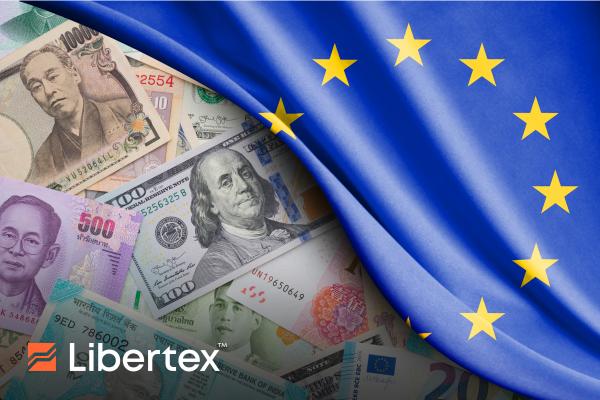It’s been a tough couple of years for Europe. Beyond the geopolitical uncertainty and energy insecurity that has been tearing the continent apart, the rate of inflation has been solidly above target and has even threatened to enter hyperinflation territory at times. Anyone in the eurozone will surely remember the torrid Q4 2022 when price pressure averaged over 10% and hit an all-time high of 11.5% in October. But after all that, it finally looks as if the worst is behind the Old Continent, despite there being no end in sight to its other problems.
As of July 2023, inflation in the European Union is down to 6.1%, while in the euro area, this figure stands at 5.5%. Naturally, this is still significantly above the usual target of around 2%, but it sure is a massive improvement on double digits. It’s also a sign that the ECB’s more hawkish policy is working as intended and that a September rate increase may be able to be avoided. For context, post-Brexit Britain is struggling with inflation of 6.8% and likely staring at another BoE rate hike of at least 25 basis points in the autumn. Of course, what traders and investors are most interested in is how this is likely to affect their investments. In this article, we’ll be covering the likely impact of this new trend on a range of asset classes, including stocks, commodities and forex.
Equitable deal
After hitting astronomical heights in 2020-2021, stocks experienced a very hard return to reality in 2022. This was followed by a seemingly unending period of stagnation for many tickers. Some of the worst affected were the biggest gainers of the pandemic era. Meme-investor darling GameStop, for example, has gained less than 1% since finding a bottom in January of this year. DocuSign, Salesforce and PayPal tell a similar story. In fact, it’s only extremely competitive and well-funded companies like Tesla and Palantir that have managed to make any sort of return to growth in 2023.
It may sound incredibly impressive that these two tech giants are up an average of 115% at 233.19 and 14.67, respectively, but these prices are actually still a whole 50% below their all-time highs, which leaves much more growth potential to be realised. China is a similar story, with huge names like Tencent, Alibaba, and Baidu languishing at multi-year lows, just begging to be snapped up by prospective investors. Meanwhile, the EuroStoxx 600 index is currently just 13% higher than it was over two decades ago in 2000. These current prices in equities the world over represent excellent value for money, and as inflation continues to drop, interest in risk assets like stocks will only increase, potentially leading to a new bull cycle in 2024.
Gold, silver and more
Any old-school investor will tell you that physical assets are what you want during times of high inflation. Some like gold and silver, others like industrial metals like copper and platinum, while others still like the day-to-day staple of oil. However, in today’s changing world, traditional strategies don’t always hold true. The yellow metal, for instance, has been fairly stagnant since the end of the pandemic and now only stands 25% above its pre-COVID levels. After flirting with its all-time high of$2014 per Troy ounce in April of this year, gold is now down around 5% to $1914 at the time of writing (23/08), and it looks as if the famed commodities supercycle is firmly off the cards for now.
It’s much the same for silver, too, which is currently hovering around $23 an ounce, down from $26 at the end of Q2 2023. Copper futures prices are also down around 10% over the same period, a trend that seems to be consistent across both stores of value and industrial metals. Despite the general global uncertainty, it appears that commodities haven’t been able to provide the safe haven many would typically predict. And with inflation, these 10% losses are actually even more pronounced. The real reason behind this phenomenon is the strong dollar, but we’ll get to that in a bit.
Don’t forget Forex
In a context of higher-than-average inflation, traditional wisdom would tell us to steer well clear of fiat currency. However, in this particular instance, that might be a bit of an oversimplification. We’ll all surely remember the historic parity achieved between the US dollar and the euro back in November 2022. Well, since then, things have certainly calmed down, but the greenback still remains much stronger than it was throughout the pandemic period. And since virtually all assets are quoted in US dollars, any gains that are made have to be offset against the value of the US national currency.
However, it’s not in pairs with the USD where the current opportunities lie in the forex market but rather in the cross rates. As we touched upon earlier, the ECB appears to be dealing with inflation much more competently than the BoE just now, and this is clearly reflected in GBP/EUR. Since the start of the month, the pair has risen from 1.15 to 1.17, and it looks as if this trend will continue unless the UK regulator takes truly decisive interest rate action in the autumn. But this is easier said than done amid a cost-of-living crisis in a country with extremely high levels of home ownership, which makes the island nation especially sensitive to any more rate increases. Shrewd investors looking to bide their time before entering riskier asset classes like stocks and crypto could well benefit from holding their cash in GBP/EUR in the meantime.
Trade it all with Libertex
Libertex is a well-respected broker with experience connecting ordinary traders and investors with the world markets.Libertex offers CFDs in a wide range of asset classes from stocks, indices and ETFs such as Tesla, Salesforce, Tencent and the EuroStoxx 50 index, all the way through to commodities and Forex pairs like XAUUSD and EURGBP. With our CFD model you can have short or long positions in all these underlying assets without having to own the instrument. With Libertex’s multi-award-winning app, you can keep your entire trading portfolio in one location for. For more information or to create an account of your own, visit https://libertex.com/signup
Risk Warning: CFDs are complex instruments and come with a high risk of losing money rapidly due to leverage. 77.77% of retail investor accounts lose money when trading CFDs with this provider. Tight spreads apply. Please check our spreads on the platform. You should consider whether you understand how CFDs work and whether you can afford to take the high risk of losing your money.


